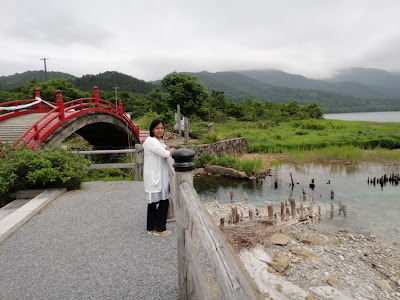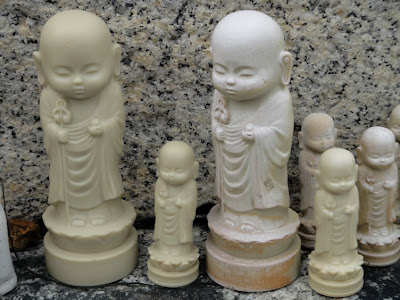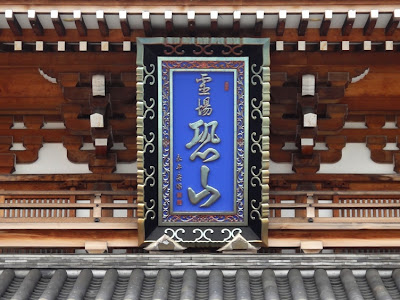On 29th June, hubby and I visited Bodaiji Temple on Mount Osore. Mount Osore, also known as Osorezan, is a caldera volcano in the center of Shimokita peninsula in Aomori prefecture. The mountain is 879 meters high and its last eruption was in 1787. It sits on the shores of a highly acidic lake named Usori. Osorezan is not an actual mountain but is a barren volcanic wasteland of bubbling sulfur pits, and a strong smell of sulfur permeates the air in the area. Osorezan is considered to be one of the three most sacred places of Japan, along with Koyasan and Hieizan.
Osorezan means ‘Fear Mountain’. According to the Japanese mythology, the mountain is considered to be the gateway for the deceased souls to their afterlife. This is because the mountain features geographical elements similar to the descriptions of Buddhist hell and paradise. At the center of the sacred area of Osorezan is Lake Usori, and next to it is a large beach covered with white sand. Surrounding them are eight mountain peaks, which represent a lotus flower with eight petals, the symbol of Buddhism. In its central area there are 108 ponds of sulfurous boiling water and mud, which corresponds to the 108 worldly desires or hell. Side by side with these hellish ponds and woods, the beautiful scenery of the lake and the coastal white sand represents paradise or heaven. According to the mythology, a deceased soul has to cross the path filled with worldly desires and reach the heaven.
Osorezan is the site of a temple named Bodaiji. The temple, also known as Entsuji, is the main attraction of the mountain. It was established by a Buddhist monk named Jikakudaishi in the year 862. The temple is run by Soto Zen sect of Buddhism, and the principal statue of worship is Jizo Bosatsu. The temple is built around a number of volcanic cauldrons (Jigoku hells) with bubbling sulfurous water in a variety of unnaturally colored shades. Scattered around the temple site on Osorezan, visitors can see many offerings made by the worshipers to the souls of the dead. Such offerings include small Jizo statues wearing bibs, brightly colored pinwheels, and piles of stones and pebbles supposed to be built by the souls of children who died before their parents. The temple organizes twice-yearly Itako Taisai Festival. The festival is held over a period of 5 days beginning July 20, as well as over a period of 3 days during the second Monday of October and the two days immediately before it. In a ritual called Kuchiyose, the bereaved and those hoping to communicate with the souls of their lost loved ones do so through mediums known as Itako who are generally blind elderly women. However, because of the disapproval of the Japanese government as well as the increasing non-religious attitude of the people, Itako are seen as a fading tradition.
On 29th June, hubby and I left our home in Yurihonjo City at about 8 am. Osorezan is located about 350 kilometers north-northeast of our home and it took us about 6 hours to reach Osorezan area by our car. Several kilometers before reaching Bodaiji Temple on Osorezan, we saw a brook, two statues, and a picturesque red colored bridge. The scenery all around us was strikingly beautiful. So we stopped our car and got out to enjoy the sceneries and the bridge. According to the Buddhist beliefs, Osorezan marks the entrance to hell. A brook named Sanzu no kawa or the ‘River of three crossings’ marks the entrance to the afterlife and is believed to be the boundary between the realms of the living and the dead. The official name of the brook is Shozugawa. Across the brook is a beautiful arched red wooden bridge, which all the souls have to cross. There are three ways of crossing over the brook. If a person has lived a good life, he can walk across the bridge and easily transition into the afterlife. If a person has lived a mediocre life, he can walk across the ford (shallow place) in the brook. However, if a person has lived a bad life, he has to wade through the waters of the brook filled with demons, dragons, and snakes. On the banks of Sanzu no kawa brook, there is a big tree under which two demons stand guarding the brook. A female demon named Datsueba strips the clothes of the dead and the male demon named Keneo weighs the clothes on tree branches to judge the Karma of the dead and decide how they should cross into the afterlife. Afterwards, the dead soul has to pass through Osorezan Hell to finally reach Lake Usori Paradise. We loved the statues of the demons. Hubby wished to walk cross the symbolic red bridge, but I told him not to as I felt a bit uncomfortable about it. However, I saw many visitors who walked across the bridge.
Statues of the demons and the red colored bridge
Seated statue of the female demon Datsueba and the standing statue of the male demon Keneo
Beautiful red colored wooden bridge across Sanzu no kawa Brook
Hubby standing near the symbolic bridge towards the ‘living’ side
The bridge across Sanzu no Kawa Brook where the right side in the photo is considered to be the ‘afterlife’ side
I am standing towards the ‘afterlife’ side of the red bridge. I did not walk across this symbolic bridge but simply walked along the car road to reach the other side.
After another ten minutes of car ride, we reached the entrance area of Bodaiji Temple on Osorezan. Near the entrance, we saw six huge Jizo statues called Rokudai Jizo who are supposed to assist people in six realms of desire and karmic reincarnation. We also saw a huge statue of Raigo Buddha who comes down to earth to welcome the souls of the dead. At the ticket counter located near the entrance area, we bought tickets worth 500 Yen per person as admission fee to enter the temple premises. We crossed the first wooden gate named Somon and entered the temple grounds.
Parking area and surrounding mountains near Osorezan Bodaiji Temple
Rokudai Jizo
I am standing near the entrance area of the temple
Statue of Raigo Buddha
Hubby looking at the map of the temple
Somon Gate
On entering the temple premises, we saw a paved pathway leading straight to another beautiful gate. We also saw several buildings on both sides of us. While walking along the pathway, we saw a stone lantern named Eidai Jyoyato which is very old and is almost decayed due to the acidic volcanic gases of the area. After a couple of minutes of walking, we saw a building named Hondo Main Hall of the temple to our left side. It is a wooden building with beautiful engraved Karahafu set into the front eves of the roof. The principal statue of worship enshrined at this hall is Daisho Shaka Nyorai. In addition, in front of the building but next to the paved pathway, we saw a statue of Jizo decked in a red bib and a hat. Right in front of this statue, we saw a pile of stones and pebbles, brightly colored pinwheels, and cute small Jizo statues, which are offerings made by the worshipers to the souls of the dead.
Straight paved pathway inside the temple premises
Old stone lantern Eidai Jyoyato
Decay of the lantern due to the acidic sulfurous gases
Hubby standing in front of Hondo Main Hall
Hondo Main Hall
Beautifully engraved roof of the hall
Details of one of the wooden engravings on the roof
Principal statue enshrined inside the hall
I am standing next to a statue of Jizo along with Hondo Main Hall in the background
The statue of Jizo with offerings of stones and pebbles, pinwheels, and cute small Jizo statues
Offerings of cute Jizo statues
After walking for another couple of steps along the paved pathway, we reached the second gate named Sanmon of the temple. It is a spectacular two storied gate with a beautiful architecture, and was rebuilt in 1989. Sanmon Gate is an elaborate wooden structure decorated with accents and carvings. A gorgeous blue colored framed plaque with ‘Reijo Osorezan’ (Sacred ground Osorezan) carved on it, hangs from the second floor of this gate. The gate has a pair of large guardian statues called Nio, one on either side of the gate. These fierce looking Nio statues are supposed to protect the temple from evil spirits. Closed mouthed Nio named Ungyo is located on the right side and opened mouthed Nio named Agyo is on the left side of the gate. After appreciating the Nio statues, we walked through the gate and found that the backside of the gate is equally magnificent.
Hubby standing in front of Sanmon Gate
Sanmon Gate
‘Reijo Osorezan’ carved on a gorgeous blue colored framed plaque
Statue of Ungyo Nio on the right side of the gate
Statue of Agyo Nio on the left side of the gate
Back side of the gate
We continued walking along the paved pathway and saw the main building of the temple straight in front of us at the other end of the premises. We noted that there are forty eight stone lanterns that adorn either side of the paved pathway. We also saw three Onsen baths named Yakushino-Yu, Furutakino-Yu and Hienukino-Yu inside the temple premises. In fact there is one more Onsen bath but we did not see it. All these Onsen baths have different temperatures and sulfur concentrations, and are believed to have medicinal effects for many ailments. Visitors can use these baths for free but we were a bit late and did not avail of the opportunity.
Inside the temple premises
I am walking along the paved pathway. Stone lanterns are seen on either side of the pathway.
A few stone lanterns
View of the volcanic sulfurous stones and pebbles to our left side while walking along the pathway
Furutakino-Yu (left) and Hienukino-Yu (right) Onsen baths to our left side
Yakushino-Yu Onsen bath to our right side
Further along the paved pathway to our right side, we saw a strange big statue of a turtle located inside a four pillared pavilion. We noted that there are many small statues of turtles inside the shell of the big one. The drawings on the carapace shell of the big turtle are stunning. In Buddhist mythology, the carapace shell of a turtle is a symbol of heaven and the plastron underside is a symbol of earth, and therefore a turtle is considered to unite heaven and earth. The turtle’s link to heaven and earth makes the statue very ideal inside this temple. In addition, a turtle also symbolizes longevity. Adjacent to the statue of the turtle, we saw Temizuya which is a hand washing basin located inside a four pillared pavilion. We washed our hands with water at the basin and purified ourselves.
Statue of a turtle inside a pavilion
Strange but very appealing statue of the turtle
Beautiful drawings on the shell of the turtle
Temizuya
After a leisurely walk along the paved pathway inside the temple premises for about ten minutes, we climbed up a few steps and reached the front of the main building named Honzon Anchi Jizoden, or simply Jizo Hall. The building is a wooden structure with beautiful engraved Karahafu set into the front eves of the roof. The principal statue of worship enshrined at this hall is Enmei Jizo Bosatsu. We prayed and made offerings for the peace of the souls of our ancestors as well as for the long life of our relatives. Afterwards, we turned around and enjoyed viewing the temple grounds from the elevated position of the hall.
Honzon Anchi Jizoden building and a few steps in front of it
Jizo Hall
Hubby standing in front of the hall
The front of the hall
Inside Jizo Hall with offertory box in the foreground
Colorful inside of the hall
Temple grounds as viewed from the front of Jizo Hall
Next we walked towards our left, along a trail surrounded by volcanic rocks and pebbles that took us further up Osorezan. This area has a strong sulfur smell due to the volcanic rocks and boiling sulfurous water all around. After about fifteen minutes of walking, we started descending down the mountain. After walking for another ten minutes, we reached Lake Usori which is considered a paradise. Standing among the volcanic rocks at the beginning of the trail, we turned around and viewed the mysterious looking temple premises.
I am walking along the trail surrounded by rocks and pebbles on Osorezan. Jizo Hall is seen in the background.
Jizo Hall as viewed from the walking trail surrounded by volcanic rocks
Two onsen bath buildings and Sanmon Gate of the temple as viewed from the walking trail surrounded by volcanic rocks
Hubby and I enjoyed viewing Bodaiji Temple on Osorezan. In the next post, I will write about our walk along the trail surrounded by volcanic rocks and pebbles on Osorezan.




































































3 comments:
Nice clicks! Liked the cute turtle statue...:)
Thank you very much for you comment Shaivi. Yeah, the turtle statue is cute :)
I really enjoyed this post and learned a lot- domo!
Post a Comment